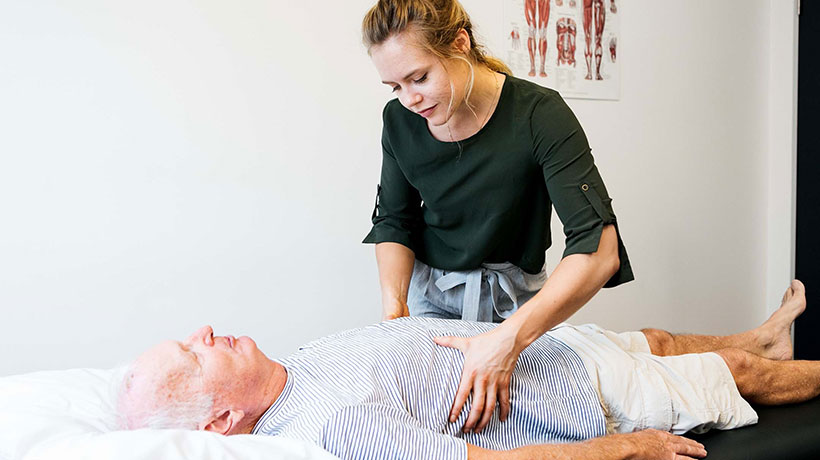
Have you ever wondered about the inner workings of your body? We regularly talk about muscles, bones and joints, but this month we switch focus to our digestive system. Without this system working properly, the rest of the body can really struggle… which is why us osteos like to keep a close eye on it.
What is the digestive system and what does it do?
The digestive system is the system that is responsible for breaking down all of the food and drink we consume into useful stuff for the body to use. It is essentially one long tube which starts at the mouth and ends at the back passage. In-between, the tube is divided into different sections, all of which have their own job in the process of food breakdown. On the journey from mouth to back passage, the tube is joined by a few assistants (called organs), which feed the tube with juices that help to mulch up the food.
The tube (or ‘gut’) is broken down into the following sections:
- Mouth: Food goes in, we chew, and the process of digestion begins with the mixture of food and saliva.
- Oesophagus (aka ‘food-pipe’): This is the connecting tube between the mouth and stomach. The food-pipe is able to push food towards the stomach using muscles in the wall of the tube. Interesting fact… We do not voluntarily control this movement, and we also cannot feel it happening!
- Stomach: An expanded section of the tube where the food is stored for a short while. Muscles of the stomach contract to mix the food with digestive juices and turn the solid food into a liquid.
- Small intestine: Juices from our liver / gallbladder and pancreas enter the tube at the beginning of the small intestine to mix and breakdown the food from the stomach to make it suitable for the body to begin to absorb. Absorption of many nutrients (including broken down carbs, proteins and fats) happens in the small intestine.
- Large intestine: This section is responsible for removing any remaining water from the food and putting it into the bloodstream, as well as forming the stool we eventually pass through our back passage. What we pass is the left-over material the body has no use for.
- Anus: The final part of the digestive system. We all know what happens here.
In a nutshell, it’s a long and winding road from food in, to stool out. The digestive system breaks down the food we eat, absorbs all of the good stuff and leaves all of the unwanted stuff for us to get rid of.
You’re asking me questions about the food I eat… all I want is help with my low back pain!
You might be thinking to yourself, why is my osteo so interested in what food I eat when I have come asking for help with pain?! It’s a fair question, and you wouldn’t be the only person to ask it. The old phrase, “you get out what you put in” is very relevant when it comes to the body. And it’s pretty simple when it’s broken down (excuse the pun!) in front of you. Our bodies require a wide range of nutrients in order to function, repair and grow. For example, we need to be able to break down carbohydrates in pasta to provide the body with glucose to use as energy, so our muscles can contract and move us around.
If we don’t feed the body with the right amount and quality of nutrients it needs, then the body can start to feel sluggish, disease can take hold, and you might not feel like you can do simple things like run or jump as easily as you used to. Our point is, your body is only as healthy as the food and drink you consume. Many of the sugary and nutrient-poor foods modern day society consumes can even lead to higher levels of inflammation in the body which can play a major role in how someone experiences pain.
This is why we are so interested in what you eat each day. Yes, as osteopaths we primarily treat the musculoskeletal system using hands-on techniques, but always remember the body is a whole. It is a maze of interlocking systems. If one system falters, it can affect the whole body until balance is restored. Dietary changes and treatment of the digestive system can have a huge impact on a person’s pain. So, the next time you are wondering why we go so deep into our questioning, this is the reason why.
Ways you can help your digestive system
If you want to get the most out of your guts, follow some of these simple rules:
- Drink plenty of fresh water every day: Remember our bodies are 70% water. We need constant replenishment of water because the body cannot produce it on its own.
- Eat a diet high in fibre: Your gut will love you. Diets poor in fibre result in digestive dysfunction including constipation.
- Keep your diet varied and full of fresh vegetables and fruits: This will help to cover you for fibre intake, as well as provide the body with important energy, vitamins and minerals.
- Give the system a rest every now and then: Our digestive system is constantly on the go. Be kind to it by not over-eating and bingeing regularly.
If you have any questions on how you can make your digestive system work better for you, speak to your osteopath during your next appointment. Don’t yet have a next appointment? Calls us today on 07 5451 1599 .
References
- Chila, AG. et al. 2011. Foundations of Osteopathic Medicine. 3rd ed. Lippincott, Williams & Wilkins: Philadelphia
- National Institute of Diabetes and Digestive and Kidney Diseases. 2017. Your Digestive System & How it Works. [Online]. Available from: https://www.niddk.nih.gov/health-information/digestive-diseases/digestive-system-how-it-works. [Accessed 08 May 2021]
